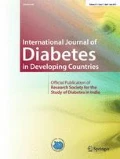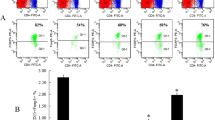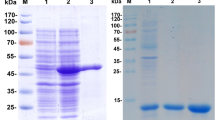Abstract
Objective
To study the effect and mechanism of Schistosoma japonicum soluble egg antigen (SEA) on protecting against type 1 diabetes, 4-week-old female BALB/c and NOD mice were divided randomly into four groups: BALB/c control, BALB/c treated with SEA, NOD control, and NOD treated with SEA.
Methods
Treated mice were injected intraperitoneally with 50 μg of SEA twice a week for 6 weeks, and control mice received the same volume of phosphate-buffered saline. Blood glucose in all mice was determined weekly from 8 weeks of age. Flow cytometry was used to detect the percentages of regulatory T cells of splenocytes in each group. Enzyme-linked immunosorbent assays were used to detect the levels of interferon-γ, interleukin (IL)-2, IL-4, and IL-5 in splenic cell culture supernatants.
Results
Compared with those of the NOD group, the blood glucose level and percentage incidence of diabetes in NOD mice treated with SEA decreased significantly. This indicated that SEA treatment prevented spontaneous type 1 diabetes. After SEA administration, the frequency of splenic regulatory T cells increased significantly, and the secretion of IL-4 and IL-5 by splenic cells increased.
Conclusions
These results demonstrated that SEA can prevent type 1 diabetes by enhancing regulatory T cells and the T helper 2 cell immune response in NOD mice.




Similar content being viewed by others
References
Saeedi P, Petersohn I, Salpea P, et al. Global and regional diabetes prevalence estimates for 2019 and projections for 2030 and 2045: results from the International Diabetes Federation Diabetes Atlas, 9(th) edition. Diabetes Res Clin Pract. 2019;157:107843.
Vukovic R, Jesic MD, Vorgucin I, et al. First report on the nationwide incidence of type 1 diabetes and ketoacidosis at onset in children in Serbia: a multicenter study. Eur J Pediatr. 2018;177:1155–62.
Weinstock JV, Elliott DE. Helminth infections decrease host susceptibility to immune-mediated diseases. J Immunol. 2014;193:3239–47.
Amdare NP, Khatri VK, Yadav RSP, et al. Therapeutic potential of the immunomodulatory proteins Wuchereria bancrofti L2 and Brugia malayi abundant larval transcript 2 against streptozotocin-induced type 1 diabetes in mice. J Helminthol. 2017;91:539–48.
Osada Y, Yamada S, Nabeshima A, et al. Heligmosomoides polygyrus infection reduces severity of type 1 diabetes induced by multiple low-dose streptozotocin in mice via STAT6- and IL-10-independent mechanisms. Exp Parasitol. 2013;135:388–96.
Lund ME, O’Brien BA, Hutchinson AT, et al. Secreted proteins from the helminth Fasciola hepatica inhibit the initiation of autoreactive T cell responses and prevent diabetes in the NOD mouse. PLoS One. 2014;9:e86289.
El-Wakil HS, Aboushousha TS, El Haddad O, et al. Effect of Schistosoma mansoni egg deposition on multiple low doses streptozotocin induced insulin dependent diabetes. J Egypt Soc Parasitol. 2002;32:987–1002.
Osada Y, Fujiyama T, Kamimura N, et al. Dual genetic absence of STAT6 and IL-10 does not abrogate anti-hyperglycemic effects of Schistosoma mansoni in streptozotocin-treated diabetic mice. Exp Parasitol. 2017;177:1–12.
Tang CL, Yu XH, Li Y, et al. Schistosoma japonicum soluble egg antigen protects against type 2 diabetes in Lepr (db/db) mice by enhancing regulatory T cells and Th2 cytokines. Front Immunol. 2019;10:1471.
Huan W, Ya-Jing L, Yan-Ru G, et al. Changes of liver fibrosis-related miRNAs induced by soluble egg antigen of Schistosoma japonicum. Zhongguo Xue Xi Chong Bing Fang Zhi Za Zhi. 2017;29:192–6.
Zaccone P, Fehérvári Z, Jones FM, et al. Schistosoma mansoni antigens modulate the activity of the innate immune response and prevent onset of type 1 diabetes. Eur J Immunol. 2003;33:1439–49.
Delovitch TL, Singh B. The nonobese diabetic mouse as a model of autoimmune diabetes: immune dysregulation gets the NOD. Immunity. 1997;7:727–38.
Cooke A, Tonks P, Jones FM, et al. Infection with Schistosoma mansoni prevents insulin dependent diabetes mellitus in non-obese diabetic mice. Parasite Immunol. 1999;21:169–76.
Maizels RM. Parasitic helminth infections and the control of human allergic and autoimmune disorders. Clin Microbiol Infect. 2016;22:481–6.
Zaccone P, Burton OT, Gibbs SE, et al. The S. mansoni glycoprotein ω-1 induces Foxp3 expression in NOD mouse CD4+T cells. Eur J Immunol. 2011;41:2709–18.
Sgouroudis E, Piccirillo CA. Control of type 1 diabetes by CD4+Foxp3+ regulatory T cells: lessons from mouse models and implications for human disease. Diabetes Metab Res Rev. 2009;25:208–18.
Kukreja A, Cost G, Marker J, et al. Multiple immuno-regulatory defects in type-1 diabetes. J Clin Invest. 2002;109:131–40.
Brode S, Raine T, Zaccone P, et al. Cyclophosphamide-induced type-1 diabetes in the NOD mouse is associated with a reduction of CD4+CD25+Foxp3+ regulatory T cells. J Immunol. 2006;177:6603–12.
El-Ahwany E, Bauiomy IR, Nagy F, et al. T regulatory cell responses to immunization with a soluble egg antigen in Schistosoma mansoni-infected mice. Korean J Parasitol. 2012;50:29–35.
Zhou S, Jin X, Chen X, et al. Heat shock protein 60 in eggs specifically induces Tregs and reduces liver immunopathology in mice with Schistosomiasis japonica. PLoS One. 2015;10:e0139133.
Pacífico LG, Marinho FA, Fonseca CT, et al. Schistosoma mansoni antigens modulate experimental allergic asthma in a murine model: a major role for CD4+ CD25+ Foxp3+ T cells independent of interleukin-10. Infect Immun. 2009;77:98–107.
Hasby EA, Hasby Saad MA, Shohieb Z, et al. FoxP3+ T regulatory cells and immunomodulation after Schistosoma mansoni egg antigen immunization in experimental model of inflammatory bowel disease. Cell Immunol. 2015;295:67–76.
Kikodze N, Pantsulaia I, Rekhviashvili Kh, et al. Cytokines and T regulatory cells in the pathogenesis of type 1 diabetes. Georgian Med News. 2013;222:29–35.
Mueller R, Krahl T, Sarvetnick N. Pancreatic expression of interleukin-4 abrogates insulitis and autoimmune diabetes in nonobese diabetic (NOD) mice. J Exp Med. 1996;184:1093–9.
Okano M, Satoskar AR, Nishizaki K, et al. Induction of Th2 responses and IgE is largely due to carbohydrates functioning as adjuvants on Schistosoma mansoni egg antigens. J Immunol. 1999;163:6712–7.
Everts B, Perona-Wright G, Smits HH, et al. Omega-1, a glycoprotein secreted by Schistosoma mansoni eggs, drives Th2 responses. J Exp Med. 2009;206:1673–80.
Maron R, Palanivel V, Weiner HL, et al. Oral administration of schistosome egg antigens and insulin B-chain generates and enhances Th2-type responses in NOD mice. Clin Immunol Immunopathol. 1998;87:85–92.
Zaccone P, Burton OT, Gibbs S, et al. Immune modulation by Schistosoma mansoni antigens in NOD mice: effects on both innate and adaptive immune systems. J Biomed Biotechnol. 2010;2010:1–13.
Jackson-Thompson BM, Torrero M, Mitre BK, et al. Axenic Caenorhabditis elegans antigen protects against development of type-1 diabetes in NOD mice. J Transl Autoimmun. 2020;3:100065.
Yan K, Wang B, Zhou H, et al. Amelioration of type 1 diabetes by recombinant fructose-1,6-bisphosphate aldolase and cystatin derived from Schistosoma japonicum in a murine model. Parasitol Res. 2020;119:203–14.
Funding
This research was supported by a National Natural Science Foundation of China grant (No. 82070810), Science and Technology Research Project of Hubei Provincial Department of Education (No. B2019362), Research Projects of Hubei Provincial Health Commission (No. WJ2017X30), and Independent Research Talents Fund Project of City College, Wuhan University of Science and Technology (No. 2019CYBSKY002). This research was funded by the scientific research subject of the health and family planning commission of Wuhan Municipality (WX20D01 and EX20D21).
Author information
Authors and Affiliations
Corresponding authors
Ethics declarations
Conflict of interest
The authors declare that they have no conflict interest.
Additional information
Publisher’s note
Springer Nature remains neutral with regard to jurisdictional claims in published maps and institutional affiliations.
Rights and permissions
About this article
Cite this article
Wang, Lx., Gao, Yr., Pan, Q. et al. Protective effect and mechanism of Schistosoma japonicum soluble egg antigen against type 1 diabetes in NOD mice. Int J Diabetes Dev Ctries 42, 363–368 (2022). https://doi.org/10.1007/s13410-021-00970-4
Received:
Accepted:
Published:
Issue Date:
DOI: https://doi.org/10.1007/s13410-021-00970-4




